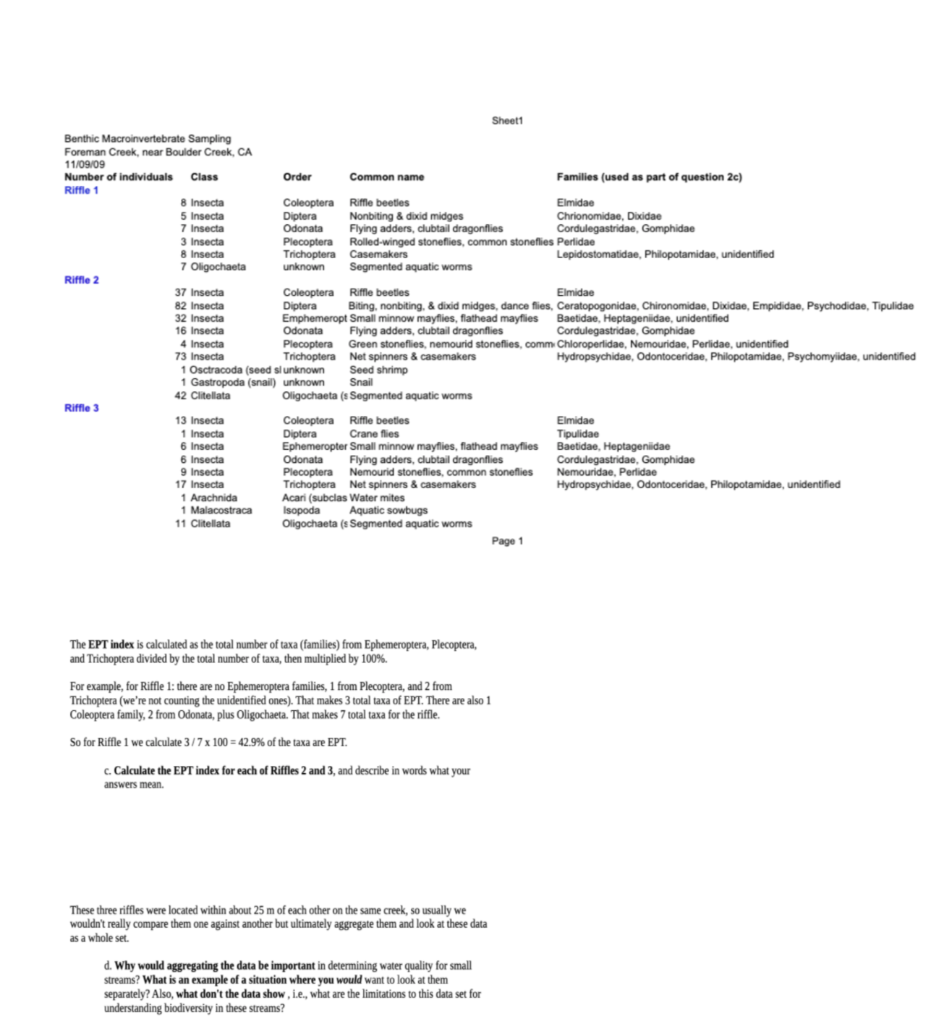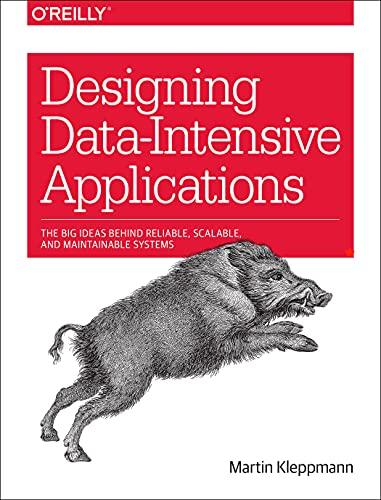
Sheet1 Benthic Macroinvertebrate Sampling Foreman Creek, near Boulder Creek, CA 11/09/09 Number of individuals Class Order Common name Families (used as part of question 2c) Riffle 1 8 Insecta Coleoptera Riffle beetles Elmidae 5 Insecta Diptera Nonbiting & dicid midges Chrionomidae, Dixidae 7 Insecta Odonata Flying adders, clubtail dragonflies Cordulegastridae, Gomphidae 3 Insecta Plecoptera Rolled-winged stoneflies, common stoneflies Perlidae 8 Insecta Trichoptera Casemakers Lepidostomatidae, Philopotamidae, unidentified , 7 Oligochaeta unknown Segmented aquatic worms Riffle 2 37 Insecta Coleoptera Riffle beetles Elmidae 82 Insecta Diptera Biting, nonbiting, & dixid midges, dance flies, Ceratopogonidae, Chironomidae, Dixidae, Empididae, Psychodidae, Tipulidae 32 Insecta Emphemeropt Small minnow mayflies, flathead mayflies Baetidae, Heptageniidae, unidentified 16 Insecta Odonata Flying adders, clubtail dragonflies Cordulegastridae, Gomphidae 4 Insecta Plecoptera Greenstoneflies, nemourid stoneflies, comm Chloroperlidae, Nemouridae, Perlidae, unidentified 73 Insecta Trichoptera Net spinners & casemakers Hydropsychidae, Odontoceridae, Philopotamidae, Psychomyiidae, unidentified 1 Osctracoda (seed slunknown Seed shrimp 1 Gastropoda (snail) unknown Snail 42 Clitellata Oligochaeta (s Segmented aquatic worms Riffle 3 13 Insecta Coleoptera Riffle beetles Elmidae 1 Insecta Diptera Crane flies Tipulidae 6 Insecta Ephemeropter Small minnow mayflies, flathead mayflies Baetidae, Heptageniidae 6 Insecta Odonata Flying adders, clubtail dragonflies Cordulegastridae, Gomphidae 9 Insecta Plecoptera Nemourid stoneflies, common stoneflies Nemouridae, Perlidae 17 Insecta Trichoptera Net spinners & casemakers Hydropsychidae, Odontoceridae, Philopotamidae, unidentified 1 Arachnida Acari (subclas Water mites 1 Malacostraca Isopoda Aquatic sowbugs 11 Clitellata Oligochaeta (s Segmented aquatic worms Page 1 The EPT index is calculated as the total number of taxa (families) from Ephemeroptera, Plecoptera, and Trichoptera divided by the total number of taxa, then multiplied by 100%. For example, for Riffle 1: there are no Ephemeroptera families, 1 from Plecoptera, and 2 from Trichoptera (we're not counting the unidentified ones). That makes 3 total taxa of EPT. There are also 1 Coleoptera family, 2 from Odonata, plus Oligochaeta. That makes 7 total taxa for the riffle. So for Riffle 1 we calculate 3/7 x 100 = 42.9% of the taxa are EPT. c. Calculate the EPT index for each of Riffles 2 and 3, and describe in words what your answers mean. These three riffles were located within about 25 m of each other on the same creek, so usually we wouldn't really compare them one against another but ultimately aggregate them and look at these data as a whole set. d. Why would aggregating the data be important in determining water quality for small streams? What is an example of a situation where you would want to look at them separately? Also, what don't the data show, i.e., what are the limitations to this data set for understanding biodiversity in these streams? Sheet1 Benthic Macroinvertebrate Sampling Foreman Creek, near Boulder Creek, CA 11/09/09 Number of individuals Class Order Common name Families (used as part of question 2c) Riffle 1 8 Insecta Coleoptera Riffle beetles Elmidae 5 Insecta Diptera Nonbiting & dicid midges Chrionomidae, Dixidae 7 Insecta Odonata Flying adders, clubtail dragonflies Cordulegastridae, Gomphidae 3 Insecta Plecoptera Rolled-winged stoneflies, common stoneflies Perlidae 8 Insecta Trichoptera Casemakers Lepidostomatidae, Philopotamidae, unidentified , 7 Oligochaeta unknown Segmented aquatic worms Riffle 2 37 Insecta Coleoptera Riffle beetles Elmidae 82 Insecta Diptera Biting, nonbiting, & dixid midges, dance flies, Ceratopogonidae, Chironomidae, Dixidae, Empididae, Psychodidae, Tipulidae 32 Insecta Emphemeropt Small minnow mayflies, flathead mayflies Baetidae, Heptageniidae, unidentified 16 Insecta Odonata Flying adders, clubtail dragonflies Cordulegastridae, Gomphidae 4 Insecta Plecoptera Greenstoneflies, nemourid stoneflies, comm Chloroperlidae, Nemouridae, Perlidae, unidentified 73 Insecta Trichoptera Net spinners & casemakers Hydropsychidae, Odontoceridae, Philopotamidae, Psychomyiidae, unidentified 1 Osctracoda (seed slunknown Seed shrimp 1 Gastropoda (snail) unknown Snail 42 Clitellata Oligochaeta (s Segmented aquatic worms Riffle 3 13 Insecta Coleoptera Riffle beetles Elmidae 1 Insecta Diptera Crane flies Tipulidae 6 Insecta Ephemeropter Small minnow mayflies, flathead mayflies Baetidae, Heptageniidae 6 Insecta Odonata Flying adders, clubtail dragonflies Cordulegastridae, Gomphidae 9 Insecta Plecoptera Nemourid stoneflies, common stoneflies Nemouridae, Perlidae 17 Insecta Trichoptera Net spinners & casemakers Hydropsychidae, Odontoceridae, Philopotamidae, unidentified 1 Arachnida Acari (subclas Water mites 1 Malacostraca Isopoda Aquatic sowbugs 11 Clitellata Oligochaeta (s Segmented aquatic worms Page 1 The EPT index is calculated as the total number of taxa (families) from Ephemeroptera, Plecoptera, and Trichoptera divided by the total number of taxa, then multiplied by 100%. For example, for Riffle 1: there are no Ephemeroptera families, 1 from Plecoptera, and 2 from Trichoptera (we're not counting the unidentified ones). That makes 3 total taxa of EPT. There are also 1 Coleoptera family, 2 from Odonata, plus Oligochaeta. That makes 7 total taxa for the riffle. So for Riffle 1 we calculate 3/7 x 100 = 42.9% of the taxa are EPT. c. Calculate the EPT index for each of Riffles 2 and 3, and describe in words what your answers mean. These three riffles were located within about 25 m of each other on the same creek, so usually we wouldn't really compare them one against another but ultimately aggregate them and look at these data as a whole set. d. Why would aggregating the data be important in determining water quality for small streams? What is an example of a situation where you would want to look at them separately? Also, what don't the data show, i.e., what are the limitations to this data set for understanding biodiversity in these streams







